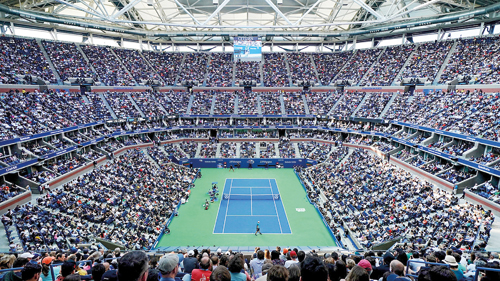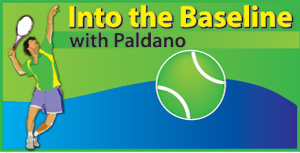Hard Court US-Open series
 The US-Open is about 138-years-old. In the past, soon after Wimbledon, the elite players packed their bags and went to New York for the US-Open. Modern Tennis is about 150-years-old. It was the ‘Davis Cup’ in 1900 that got the US public into the game. With it the USA was smitten by Tennis.
The US-Open is about 138-years-old. In the past, soon after Wimbledon, the elite players packed their bags and went to New York for the US-Open. Modern Tennis is about 150-years-old. It was the ‘Davis Cup’ in 1900 that got the US public into the game. With it the USA was smitten by Tennis.To create and sustain Clay and Grass Tennis Courts is a considerable challenge. This gave birth to Hard Courts. Again, the cost of equipment, for players to get on to the court, was and is not within the reach of many.
It also takes considerable effort to find a court and suitable Tennis partners for an afternoon of Tennis anywhere in the world. The popularity of Tennis and the prosperity of countries are connected. With the advent of professionalism, good star studded events are extremely difficult to achieve.
Europe and USA were the original Tennis playing continents. After the 1930s’ Australia too became a serious contender at Tennis. With the unprecedented economic growth of the world, the number of prosperous regions in the world has increased. They too want Tennis on their soil. At present, many countries want to be identified with Tennis. This is pushing the US to do more to keep Tennis’ popularity on its soil, high.
New image for American Tennis
The US-Open, as an attraction, waned after the world domination of Americans Chuck McKinley, Dennis Ralston, Arthur Ashe, John McEnroe, Jimmy Connors and Andre Agassi among Men, and Billie Jean King, Julie Heldman, Rosemary Casals, Chris Evert, Devanport and Williams sisters among Women. At present, US domination of the game in the global arena is very much less than what it was. So is the interest for the game in the US.
Tennis, from its competitive inception, was never played in a Carnival atmosphere. It was and is a game of mental concentration. Pop culture, loud music, carnival atmosphere and Tennis were never together. In recent times, the US had to bring these into the US-Open Centre court to revive Tennis. Even that is not doing well.
To make it worthwhile for players to travel to North America, the US-Open has connected a string of events, which includes one in Canada. It is called the US-Open series. They are all on Hard Courts like the US-Open courts. There are 5 events in North America, leading to the US-Open. They are Atlanta, San Jose, Montreal/Toronto, Cincinnati, Salem and Connecticut. To enhance its appeal, the US-Open prize money in 2018 has gone up to US$ 53 million. ‘Please come’ the sign board reads.
The US-Open is a mandatory event for players in the top 128 of the world ranking in both genders. That keeps the US-Open safe in good player appearance. The other events prior to the US-Open have no strong attraction to lure good players. In the professional calendar, pre US-Open period has events in Eastern and Western Europe, China and South America. These have matching or better prize money.
Spectator issue
Unfortunately, in Tennis, only the best players attract spectators. Other matches such as local championships and age group matches will only see the attendance of ‘participant’s interested parties’. What’s more, now the bigger spectatorship of sport is through the electronic media? For the media global broadcast only the top 100 in the world ranking matters.
Appearance money is officially prohibited and we know very little about it, because nothing is revealed about it. If I am to mention anything about appearance money, it would be pure speculation. One cannot even confirm if this exists.
For the event organisers, all of these issues are a ‘Catch 22’ situation. Public opinion versus event success. A very uncomfortable position to be in.
Impact of events
The unseen, but heavily felt, issue of events is the impact it has on round-the-year popularity of the game in a country. For administrations, this is a notoriously difficult matter to handle, as the final phase of national player development. Positive impact of events propel popularity. Likewise, the opposite is also true. It being an ever changing situation, staying ahead is the only guarantee against it. Very easily said and could be the most difficult to achieve.
 Hard Court time
Hard Court time
Top ranked players in the US-Open Series will be coming after 8 weeks of Clay Court events and 4 weeks of Grass Court events in Europe. That makes it the best time for trophy hunting and kill the best. Most of today’s good players had their development on Hard Courts. That makes every player a possible giant killer at the US-Open. The Hard Court is fast, vibrant and does not need the variance of Clay and Grass tactics to win. Sheer speed is the winning weapon.
This year, to win the US-Open, in both genders, the favourites are the top 10 ranked players. In the quarterfinals berths of French-Open and Wimbledon this year, we saw little of the Top 10 players. This could be the case too, in this year’s US-Open.
This is the most difficult period of the professional circuit. Most of the players are physically and emotionally burnt out. Money is big in the US-Open this year, good form will strike gold. 2018 Wimbledon was won by Kerber and Djokovic. The World will be watching.
George Paldano, Former int. player; Accredited Coach of German Federation; National coach Sri Lanka & Brunei, Davis-Cup, Federation Cup captain/coach– contact 94 77 544 8880 geodano2015@gmail.com –


